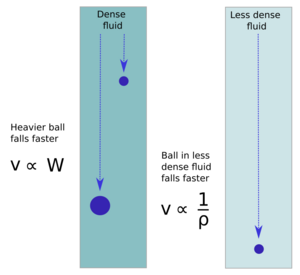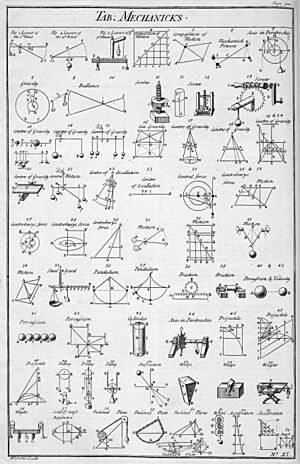History of classical mechanics facts for kids
In physics, mechanics is the study of how objects move and interact. It's about understanding why things fall, how they push each other, and what makes them stop or go. Classical mechanics is a part of mechanics that looks at how things work in our everyday world, without getting into super-fast speeds (like near the speed of light) or tiny particles (like atoms). Most of the ideas in classical mechanics were developed before the 1900s.
A huge moment in classical mechanics was when Isaac Newton published his laws of motion in 1678. He also developed calculus, a special type of math needed to understand these laws. Over the next two centuries, new math tools like Hamiltonian mechanics were created. These ideas were very important for the later development of quantum mechanics and relativity.
Contents
Early Ideas About Motion
Ancient Thinkers
Long ago, ancient Greek thinkers, especially Aristotle, were among the first to suggest that nature follows certain rules. Aristotle believed that things on Earth would naturally move to their "natural place." For example, he thought heavy objects fell faster than light ones. He also believed that objects would stop moving if no force was pushing them.
Aristotle thought a vacuum (a space with nothing in it) was impossible. He also believed that an object would stop moving in an "unnatural" direction once the force pushing it was gone. Later, some of his followers tried to explain why an arrow kept flying after being shot. They thought the arrow created a vacuum behind it, and air rushed in to push it forward.
Other ancient Greeks, like Archimedes, used math to study how things balance and float. Later, scholars in Islamic and Byzantine cultures built on these ideas. Their work eventually came back to Europe during the Renaissance.
Medieval Discoveries
A Persian scholar named Ibn Sīnā wrote about his ideas on motion around 1020. He suggested that when you throw something, you give it an "impetus" (a kind of push or force). He believed this impetus kept the object moving until things like air resistance made it stop. Ibn Sina even thought that if an object was in a vacuum, it would never stop moving unless something else acted on it. This idea is very similar to Newton's first law of motion, which is about inertia.
In the 12th century, Hibat Allah Abu'l-Barakat al-Baghdaadi built on Ibn Sina's ideas. He said that a mover gives a "violent inclination" to an object, which then slowly fades away. This was an early step toward understanding that a constant force causes acceleration, not just uniform motion.
Later, in the 14th century, a French priest named Jean Buridan developed the theory of impetus further.
Renaissance Changes
Galileo Galilei made a lot of important discoveries. He used his telescope to observe the sky, which challenged old ideas about the heavens. He believed the Earth was a planet like others, moving around the Sun, just as Copernicus had suggested.
Galileo did experiments by rolling balls down an inclined plane (a ramp). From these tests, he figured out how objects speed up as they fall. He also found that if you drop something and throw something horizontally at the same time, they hit the ground together. This showed that Earth's rotation didn't stop objects from falling straight down.
Galileo also realized that if something is moving at a steady speed, it's hard to tell if it's moving or standing still without looking at something else. This idea became a basic part of the theory of relativity.
Christiaan Huygens was another important scientist. He figured out how energy is conserved when objects bounce off each other. He also studied how things swing back and forth and invented the pendulum clock.
Newton's Big Ideas
Isaac Newton was the first to bring together three main laws of motion. These laws explain how things move on Earth and how planets move in space. Newton and other scientists of his time hoped that classical mechanics could explain everything, even light.
Newton also developed calculus, the math needed to solve problems in classical mechanics. However, it was Gottfried Leibniz who, working separately, created the symbols for calculus (like the ones for derivatives and integrals) that we still use today.
Later, Leonhard Euler expanded Newton's laws to include how solid objects behave when forces are applied to them. This led to understanding how materials stretch and bend, which is important for building strong structures.
Advanced Mechanics
After Newton, scientists found new ways to solve even more complex problems. In 1788, Joseph Louis Lagrange developed Lagrangian mechanics. This method looks for the path an object takes that requires the "least action" (a specific physics concept). Then, in 1833, William Rowan Hamilton created Hamiltonian mechanics.
These advanced methods were not just useful for classical physics. They also became the foundation for quantum mechanics, which describes the world of tiny particles.
Challenges in the Late 1800s
Even though classical mechanics worked well for many things, scientists found some problems in the late 1800s. For example, when classical mechanics was combined with ideas about heat (thermodynamics), it led to some confusing results about entropy (a measure of disorder).
Also, when scientists started looking at atoms, classical mechanics couldn't explain how atoms worked or why they had certain energy levels. These problems led to the development of quantum mechanics.
Another issue was how forces like gravity and electromagnetism seemed to act instantly over a distance. This was hard to explain. Also, classical mechanics and electromagnetism seemed to behave differently when objects moved at high speeds. These challenges eventually led Albert Einstein to develop his special relativity theory.
Modern Physics
At the start of the 20th century, two new big ideas changed physics: quantum mechanics (around 1900) and relativistic mechanics (around 1905). These discoveries showed that classical mechanics was actually a good approximation, but not the full picture.
Einstein's theory of relativity later included general relativity (1915). This theory completely changed how we think about gravity, explaining it as the bending of spacetime. Relativistic mechanics is needed when things move very fast, close to the speed of light. But if speeds are much slower, it gives the same answers as Newton's mechanics.
Quantum mechanics describes the world of atoms and even smaller particles. It was updated in 1915 to quantum field theory, which led to the Standard Model of elementary particles. This model describes the basic particles and forces like electromagnetism. Quantum mechanics explains how things work at the tiny scale, but for larger, everyday objects, it gives the same results as classical mechanics.
Scientists are still working on combining general relativity and quantum field theory into one single theory of quantum gravity. This is one of the biggest unsolved problems in physics today!
See also
- Mechanics
- Timeline of classical mechanics



